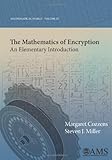The mathematics of encryption : an elementary introduction
Material type: TextSeries: Mathematical World ; Vol. 29Publication details: Rhode Island: American Mathematical Society, [c2013]Description: 322 pISBN: 978-0821883211Subject(s): MathematicsLOC classification: QA268
TextSeries: Mathematical World ; Vol. 29Publication details: Rhode Island: American Mathematical Society, [c2013]Description: 322 pISBN: 978-0821883211Subject(s): MathematicsLOC classification: QA268| Item type | Current library | Collection | Shelving location | Call number | Status | Notes | Date due | Barcode | Item holds |
|---|---|---|---|---|---|---|---|---|---|
 Book
Book
|
ICTS | Mathematic | Rack No 5 | QA268 (Browse shelf (Opens below)) | Available | Billno:IN 003 582; Billdate: 2018-01-11 | 00984 |
Browsing ICTS shelves, Shelving location: Rack No 5 Close shelf browser (Hides shelf browser)
1. Historical introduction
2. Classical cryptology: Methods
3. Enigma and Ultra
4. Classical cryptography: Attacks I
5. Classical cryptography: Attacks II
6. Modern symmetric encryption
7. Introduction to public-channel cryptography
8. Public-channel cryptography
9. Error detecting and correcting codes
10. Modern cryptography
11. Primality testing and factorization
12. Solutions to selected exercises
This book provides a historical and mathematical tour of cryptography, from classical ciphers to quantum cryptography. The authors introduce just enough mathematics to explore modern encryption methods, with nothing more than basic algebra and some elementary number theory being necessary. Complete expositions are given of the classical ciphers and the attacks on them, along with a detailed description of the famous Enigma system. The public-key system RSA is described, including a complete mathematical proof that it works. Numerous related topics are covered, such as efficiencies of algorithms, detecting and correcting errors, primality testing and digital signatures. The topics and exposition are carefully chosen to highlight mathematical thinking and problem solving. Each chapter ends with a collection of problems, ranging from straightforward applications to more challenging problems that introduce advanced topics. Unlike many books in the field, this book is aimed at a general liberal arts student, but without losing mathematical completeness. --- summary provided by publisher









There are no comments on this title.